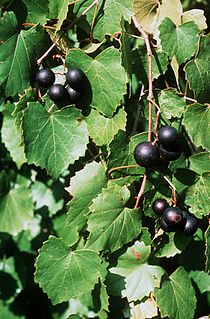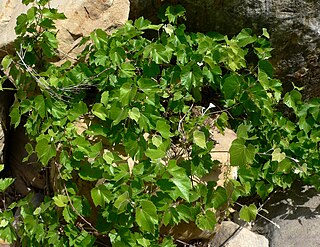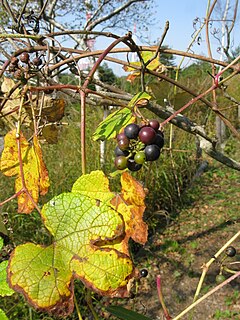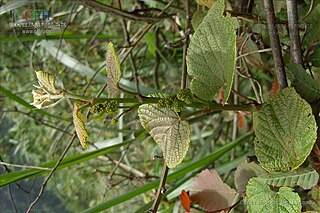
Vitis rotundifolia, or muscadine, is a grapevine species native to the southeastern and south-central United States. The growth range extends from Florida to New Jersey coast, and west to eastern Texas and Oklahoma. It has been extensively cultivated since the 16th century. The plants are well-adapted to their native warm and humid climate; they need fewer chilling hours than better known varieties, and thrive in summer heat.

Vitis riparia Michx, with common names riverbank grape or frost grape, is a vine indigenous to North America. As a climbing or trailing vine, it is widely distributed across central and eastern Canada and the central and northeastern parts of the United States, from Quebec to Texas, and eastern Montana to Nova Scotia. There are reports of isolated populations in the northwestern USA, but these are probably naturalized. It is long-lived and capable of reaching into the upper canopy of the tallest trees. It produces dark fruit that are appealing to both birds and people, and has been used extensively in commercial viticulture as grafted rootstock and in hybrid grape breeding programs.

Vitis aestivalis, the summer grape, or pigeon grape is a species of grape native to eastern North America from southern Ontario east to Maine, west to Oklahoma, and south to Florida and Texas. It is a vigorous vine, growing to 10 m or more high in trees. The leaves are 7–20 cm long, suborbicular, and usually a little broader than long; they are variable in shape, from unlobed to deeply three- or five-lobed, green above, and densely hairy below. The flowers are produced at every 3rd node in a dense panicle 5–15 cm long. The fruit is a small grape 5–14 mm diameter, dark purple or black in colour. It is the official state grape of Missouri. Summer grape prefers a drier upland habitat.

Vitis mustangensis, commonly known as the mustang grape, is a species of grape that is native to the southern United States. Its range includes parts of Mississippi, Alabama, Louisiana, Texas, and Oklahoma.

Vitis davidii is a species of vining plant native to Asia. The plant grows to a height of up to 8 m (25 ft) and bears small, black grapes. It is also known as the chinese bramble grape.
Vitis adenoclada is a species of plant in the grape family. It is found in the province of Hunan in China, where the climate is temperate.

Vitis shuttleworthii is a North American liana in the grape family commonly known as the calloose grape or bear grape. The name refers to the group of Native American people that resided in southwest FL, the Calusa. It is native to south and central Florida, with isolated populations in southern Alabama.
Vitis balansana is a species of climbing vine in the grape family native to temperate and tropical Asia. Its native range encompasses Vietnam and three southeastern provinces in China The habitat of V. balansana varies; it has adapted to living under forest cover, and in sun-soaked shrubland valleys, at between 200–800 meters.
Vitis blancoi is a species of liana in the grape family which bears black berries, and is native to western Mexico.
Vitis nesbittiana is a species of liana in the grape family. It is native to central Mexico (Veracruz).
Vitis betulifolia is a widely ranging species of liana in the grape family native to China where its habitat is forested or shrubby valleys and hillsides, at elevations from 600 to 3,600 metres.

Vitis arizonica is a North American species of wild grape. It is a deciduous vine.

Vitis flexuosa is a species of liana in the grape family.

Vitis ficifolia is a species of liana in the grape family native to the Asian temperate climate zone. It is found in mainland China, Japan, Taiwan and the Koreas.
Vitis monticola, commonly known as mountain grape, or sweet mountain grape, is a North American species of wild grape native to Texas. It is important to grape growers for its resistance to drought; a quality exploited both genetically in hybridization, and in grafting.
Vitis jaegeriana is a plant species in the grape family that is endemic to North-Central Mexico.
Vitis xunyangensis is an Old World species of wild grape native to temperate China.
Vitis heyneana is a species of climbing vine in the grape family endemic to Asia. It can be found in shrubby or forested areas, from almost sea-level, to 3200 meters above. It has globose berries that are purple to almost black.
Vitis popenoei, commonly called the totoloche, or totoloche grape, is a New World species of liana in the grape family native to Belize, Mexico, and north-central Guatemala.

Vitis wilsoniae is a vining plant in the grape family native to China. It is commonly known as the net veined grape or reticulated grape. This species can be found in the provinces of Anhui, Chongqing, Fujian, Gansu, Guizhou, Henan, Hubei, Hunan, Shaanxi, Sichuan, Yunnan, and Zhejiang. The plant grows at altitudes of 400-2000m.










